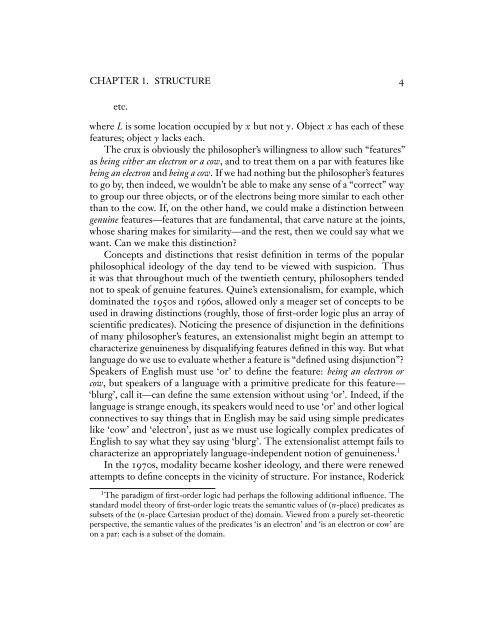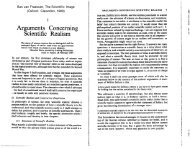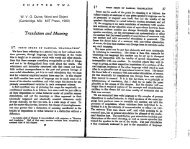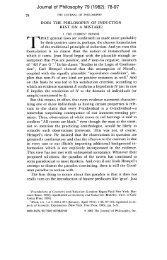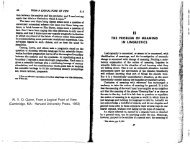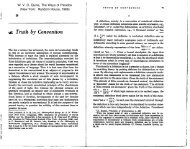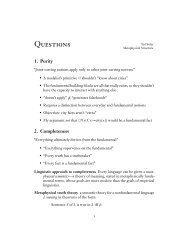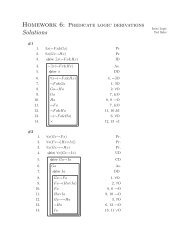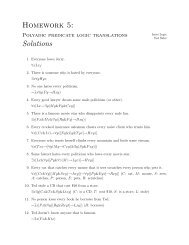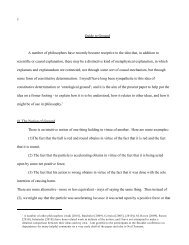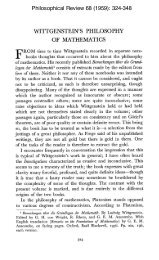Writing the Book of the World - Ted Sider
Writing the Book of the World - Ted Sider
Writing the Book of the World - Ted Sider
Create successful ePaper yourself
Turn your PDF publications into a flip-book with our unique Google optimized e-Paper software.
CHAPTER 1. STRUCTURE 4<br />
etc.<br />
where L is some location occupied by x but not y. Object x has each <strong>of</strong> <strong>the</strong>se<br />
features; object y lacks each.<br />
The crux is obviously <strong>the</strong> philosopher’s willingness to allow such “features”<br />
as being ei<strong>the</strong>r an electron or a cow, and to treat <strong>the</strong>m on a par with features like<br />
being an electron and being a cow. If we had nothing but <strong>the</strong> philosopher’s features<br />
to go by, <strong>the</strong>n indeed, we wouldn’t be able to make any sense <strong>of</strong> a “correct” way<br />
to group our three objects, or <strong>of</strong> <strong>the</strong> electrons being more similar to each o<strong>the</strong>r<br />
than to <strong>the</strong> cow. If, on <strong>the</strong> o<strong>the</strong>r hand, we could make a distinction between<br />
genuine features—features that are fundamental, that carve nature at <strong>the</strong> joints,<br />
whose sharing makes for similarity—and <strong>the</strong> rest, <strong>the</strong>n we could say what we<br />
want. Can we make this distinction?<br />
Concepts and distinctions that resist definition in terms <strong>of</strong> <strong>the</strong> popular<br />
philosophical ideology <strong>of</strong> <strong>the</strong> day tend to be viewed with suspicion. Thus<br />
it was that throughout much <strong>of</strong> <strong>the</strong> twentieth century, philosophers tended<br />
not to speak <strong>of</strong> genuine features. Quine’s extensionalism, for example, which<br />
dominated <strong>the</strong> 1950s and 1960s, allowed only a meager set <strong>of</strong> concepts to be<br />
used in drawing distinctions (roughly, those <strong>of</strong> first-order logic plus an array <strong>of</strong><br />
scientific predicates). Noticing <strong>the</strong> presence <strong>of</strong> disjunction in <strong>the</strong> definitions<br />
<strong>of</strong> many philosopher’s features, an extensionalist might begin an attempt to<br />
characterize genuineness by disqualifying features defined in this way. But what<br />
language do we use to evaluate whe<strong>the</strong>r a feature is “defined using disjunction”?<br />
Speakers <strong>of</strong> English must use ‘or’ to define <strong>the</strong> feature: being an electron or<br />
cow, but speakers <strong>of</strong> a language with a primitive predicate for this feature—<br />
‘blurg’, call it—can define <strong>the</strong> same extension without using ‘or’. Indeed, if <strong>the</strong><br />
language is strange enough, its speakers would need to use ‘or’ and o<strong>the</strong>r logical<br />
connectives to say things that in English may be said using simple predicates<br />
like ‘cow’ and ‘electron’, just as we must use logically complex predicates <strong>of</strong><br />
English to say what <strong>the</strong>y say using ‘blurg’. The extensionalist attempt fails to<br />
characterize an appropriately language-independent notion <strong>of</strong> genuineness. 1<br />
In <strong>the</strong> 1970s, modality became kosher ideology, and <strong>the</strong>re were renewed<br />
attempts to define concepts in <strong>the</strong> vicinity <strong>of</strong> structure. For instance, Roderick<br />
1 The paradigm <strong>of</strong> first-order logic had perhaps <strong>the</strong> following additional influence. The<br />
standard model <strong>the</strong>ory <strong>of</strong> first-order logic treats <strong>the</strong> semantic values <strong>of</strong> (n-place) predicates as<br />
subsets <strong>of</strong> <strong>the</strong> (n-place Cartesian product <strong>of</strong> <strong>the</strong>) domain. Viewed from a purely set-<strong>the</strong>oretic<br />
perspective, <strong>the</strong> semantic values <strong>of</strong> <strong>the</strong> predicates ‘is an electron’ and ‘is an electron or cow’ are<br />
on a par: each is a subset <strong>of</strong> <strong>the</strong> domain.


